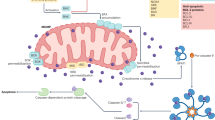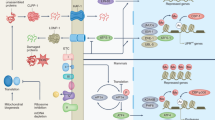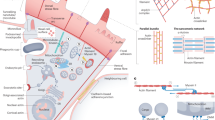Abstract
Evidence from many organisms has shown that the accumulation of reactive oxygen species (ROS) has a detrimental effect on cell well-being. High levels of ROS have been linked to programmed cell death pathways and to ageing. Recent reports have implicated changes to the dynamics of the actin cytoskeleton in the release of ROS from mitochondria and subsequent cell death.
This is a preview of subscription content, access via your institution
Access options
Subscribe to this journal
Receive 12 print issues and online access
$209.00 per year
only $17.42 per issue
Buy this article
- Purchase on SpringerLink
- Instant access to full article PDF
Prices may be subject to local taxes which are calculated during checkout





Similar content being viewed by others
References
Frohlich, K. U. & Madeo, F. Apoptosis in yeast: a new model for aging research. Exp. Gerontol. 37, 27–31 (2001).
Jin, C. & Reed, J. C. Yeast and apoptosis. Nature Rev. Mol. Cell Biol. 3, 453–459 (2002).
Laun, P. et al. Aged mother cells of Saccharomyces cerevisiae show markers of oxidative stress and apoptosis. Mol. Microbiol. 39, 1166–1173 (2001).
Herker, E. et al. Chronological aging leads to apoptosis in yeast. J. Cell Biol. 164, 501–507 (2004).
Fabrizio, P. et al. Superoxide is a mediator of an altruistic aging program in Saccharomyces cerevisiae. J. Cell Biol. 166, 1055–1067 (2004).
Raha, S. & Robinson, B. H. Mitochondria, oxygen free radicals, disease and ageing. Trends Biol. Sci. 25, 502–508 (2000).
Du, G., Mouithys-Mickalad, A. & Sluse, F. E. Generation of superoxide anion by mitochondria and impairment of their functions during anoxia and reoxygenation in vitro. Free Radic. Biol. Med. 25, 1066–1074 (1998).
Mandavilli, B. S., Santos, J. H. & Van Houten, B. Mitochondrial repair and ageing. Mutat. Res. 509, 127–151 (2002).
Ayscough, K. R. & Drubin, D. G. Actin: general principles from studies in yeast. Annu. Rev. Cell Devel. Biol. 12, 129–160 (1996).
Gourlay, C. W., Carpp, L. N., Timpson, P., Winder, S. J. & Ayscough, K. R. A role for the actin cytoskeleton in cell death and aging in yeast. J. Cell Biol. 164, 803–809 (2004).
Thweatt, R., Lumpkin, C. K. & Goldstein, S. A novel gene encoding a smooth-muscle protein is overexpressed in senescent human fibroblasts. Biochem. Biophys. Res. Comm. 187, 1–7 (1992).
Gonos, E. S. et al. Cloning and identification of genes that associate with mammalian replicative senescence. Exp. Cell Res. 240, 66–74 (1998).
Dumont, P. et al. Induction of replicative senescence biomarkers by sublethal oxidative stresses in normal human fibroblast. Free Radic. Biol. Med. 28, 361–373 (2000).
Prinjha, R. K. et al. Cloning and sequencing of cDNAs encoding the actin cross-linking protein transgelin defines a new family of actin-associated proteins. Cell Motil. Cytoskel. 28, 243–255 (1994).
Camoretti-Mercado, B. et al. Expression and cytogenetic localization of the human SM22 gene (TAGLN). Genomics 49, 452–457 (1998).
Winder, S. J., Jess, T. & Ayscough, K. R. SCP1 encodes an actin-bundling protein in yeast. Biochem. J. 375, 287–295 (2003).
Posey, S. & Bierer, B. Actin stabilization by jasplakinolide enhances apoptosis induced by cytokine deprivation. J. Biol. Chem. 274, 4259–4265 (1999).
Odaka, C., Sanders, M. L. & Crews, P. Jasplakinolide induces apoptosis in various transformed cell lines by a caspase-3-like protease-dependent pathway. Clin. Diagn. Lab. Immunol. 7, 947–952 (2000).
Kwiatkowski, D. J. Functions of gelsolin: motility, signaling, apoptosis, cancer. Curr. Opin. Cell Biol. 11, 103–108 (1999).
Ohtsu, M. et al. Inhibition of apoptosis by the actin-regulatory protein gelsolin. EMBO J. 16, 4650–4656 (1997).
Koya, R. C. et al. Gelsolin inhibits apoptosis by blocking mitochondrial membrane potential loss and cytochrome c release. J. Biol. Chem. 275, 15343–15349 (2000).
Harms, C. et al. Neuronal gelsolin prevents apoptosis by enhancing actin depolymerization. Mol. Cell. Neurosci. 25, 69–82 (2004).
Endres, M. et al. Neuroprotective effects of gelsolin during murine stroke. J. Clin. Invest. 103, 347–354 (1999).
Chua, B. T. et al. Mitochondrial translocation of cofilin is an early step in apoptosis induction. Nature Cell Biol. 12, 1083–1089 (2003).
Utsumi, T., Sakurai, N., Nakano, K. & Ishisaka, R. C-terminal 15 kDa fragment of cytoskeletal actin is posttranslationally N-myristoylated upon caspase-mediated cleavage and targeted to mitochondria. FEBS Lett. 539, 37–44 (2003).
Mashima, T., Naito, M. & Tsuruo, T. Caspase-mediated cleavage of cytoskeletal actin plays a positive role in the process of morphological apoptosis. Oncogene 18, 2423–2430 (1999).
Mashima, T., Naito M., Fujita N., Noguchi, K. & Tsuruo, T. Identification of actin as a substrate of ICE and an ICE-like protease and involvement of an ICE-like protease but not ICE in Vp-16-induced U937 apoptosis. Biochem. Biophys. Res. Comm. 217, 1185–1192 (1995).
Kothakota, S. et al. Caspase-3-generated fragment of gelsolin: effector of morphological change in apoptosis. Science 278, 294–298 (1997).
Kusano, H., et al. Human gelsolin prevents apoptosis by inhibiting apoptotic mitochondrial changes via closing VDAC. Oncogene 19, 4807–4814 (2000).
Tsujimoto, Y. & Shimizu, S. The voltage-dependent anion channel: an essential player in apoptosis. Biochimie 84, 187–193 (2002).
Xu, X., Forbes, J. G. & Colombini, M. Actin modulates the gating of Neurospora crassa VDAC. J. Membr. Biol. 180, 73–81 (2001).
Rosenmund, C. & Westbrook, G. L. Calcium-induced actin depolymerization reduces NMDA channel activity. Neuron 10, 805–814 (1993).
Furukawa, K. et al. The actin-severing protein gelsolin modulates calcium channel and NMDA receptor activities and vulnerability to excitotoxicity in hippocampal neurons. J. Neurosci. 17, 8178–8186 (1997).
Wang, Y., Mattson, M. P. & Furukawa, K. Endoplasmic reticulum calcium release is modulated by actin polymerization. J. Neurochem. 82, 945–952 (2002).
Hajnoczky, G., Csordas, G. & Yi, M. Old players in a new role: mitochondria-associated membranes, VDAC, and ryanodine receptors as contributors to calcium signal propagation from endoplasmic reticulum to the mitochondria. Cell Calcium 32, 363–377 (2002).
Gincel, D., Zaid, H. & Shoshan-Barmatz, V. Calcium binding and translocation by the voltage-dependent anion channel: a possible regulatory mechanism in mitochondrial function. Biochem. J. 358, 147–155 (2001).
Rolland, F., Winderickx, J. & Thevelein, J. M. Glucose-sensing and -signalling mechanisms in yeast. FEMS Yeast Res. 2, 183–201 (2002).
Ho, J. & Bretscher, A. Ras regulates the polarity of the yeast actin cytoskeleton through the stress response pathway. Mol. Biol. Cell 12, 1541–1555 (2001).
Gourlay, C. W. & Ayscough, K. R. Identification of an upstream regulatory pathway controlling actin-mediated apoptosis in yeast. J. Cell Sci. 118, 2119–2132 (2005).
Li, J. et al. β-actin is required for mitochondria clustering and ROS generation in TNF-induced, caspase-independent cell death. J. Cell Sci. 117, 4673–4680 (2004).
Daniel, J. L., Molish, I. R., Robkin, L. & Holmsen, H. Nucleotide exchange between cytosolic ATP and F-actin-bound ADP may be a major energy-utilizing process in unstimulated platelets. Eur. J. Biochem. 156, 677–684 (1986).
Bernstein, B. W. & Bamburg, J. R. Actin–ATP hydrolysis is a major energy drain for neurons. J. Neurosci. 23, 1–6 (2003).
Atkinson, S. J., Hosford, M. A. & Molitoris, B. A. Mechanism of actin polymerization in cellular ATP depletion. J. Biol. Chem. 279, 5194–5199 (2004).
Bamburg, J. R. & Wiggan, O. P. ADF/cofilin and actin dynamics in disease. Trends Cell Biol. 12, 598–605 (2002).
Ashworth, S. L. et al. ADF/cofilin mediates actin cytoskeletal alterations in LLC-PK cells during ATP depletion. Am. J. Physiol. Renal Physiol. 284, F852–F862 (2003).
Minamide, L. S., Striegl, A. M., Boyle, J. A., Meberg, P. J. & Bamburg, J. R. Neurodegenerative stimuli induce persistent ADF/cofilin–actin rods that disrupt distal neurite function. Nature Cell Biol. 9, 628–636 (2000).
Madeo, F. et al. A caspase-related protease regulates apoptosis in yeast. Mol. Cell 9, 911–917 (2002).
Wissing, S. et al. An AIF orthologue regulates apoptosis in yeast. J. Cell Biol. 166, 969–974 (2004).
MacLean, M., Harris, N. & Piper, P. W. Chronological lifespan of stationary phase yeast cells; a model for investigating the factors that might influence the ageing of postmitotic tissues in higher organisms. Yeast 18, 499–509 (2001).
Tissenbaum, H. & Guarente, L. Model organisms as a guide to mammalian ageing. Dev. Cell 1, 9–19 (2002).
Lai, C. Y., Jaruga, E., Borghouts, C. & Jazwinski, S. M. A mutation in the ATP2 gene abrogates the age asymmetry between mother and daughter cells of the yeast Saccharomyces cerevisiae. Genetics 162, 73–87 (2002).
Smeal, T., Claus, J., Kennedy, B., Cole, F. & Guarente, L. Loss of transcriptional silencing causes sterility in old mother cells of S. cerevisiae. Cell 84, 633–642 (1996).
Acknowledgements
We thank S. Winder and P. Mitchell for critical reading of this manuscript. K.R.A. and C.W.G. are supported by a Medical Research Council (MRC) senior research fellowship to K.R.A.
Author information
Authors and Affiliations
Corresponding author
Ethics declarations
Competing interests
The authors declare no competing financial interests.
Related links
Related links
DATABASES
Entrez Gene
Swiss-Prot
FURTHER INFORMATION
Rights and permissions
About this article
Cite this article
Gourlay, C., Ayscough, K. The actin cytoskeleton: a key regulator of apoptosis and ageing?. Nat Rev Mol Cell Biol 6, 583–589 (2005). https://doi.org/10.1038/nrm1682
Published:
Issue Date:
DOI: https://doi.org/10.1038/nrm1682
This article is cited by
-
Development of primary osteoarthritis during aging in genetically diverse UM-HET3 mice
Arthritis Research & Therapy (2024)
-
Empagliflozin attenuates cardiac microvascular ischemia/reperfusion injury through improving mitochondrial homeostasis
Cardiovascular Diabetology (2022)
-
Switching cell fate by the actin–auxin oscillator in Taxus: cellular aspects of plant cell fermentation
Plant Cell Reports (2022)
-
The effects of 808-nm near-infrared laser light irradiation on actin cytoskeleton reorganization in bone marrow mesenchymal stem cells
Cell and Tissue Research (2021)
-
Fascin promotes the invasion of pituitary adenoma through partial dependence on epithelial–mesenchymal transition
Journal of Molecular Histology (2021)



